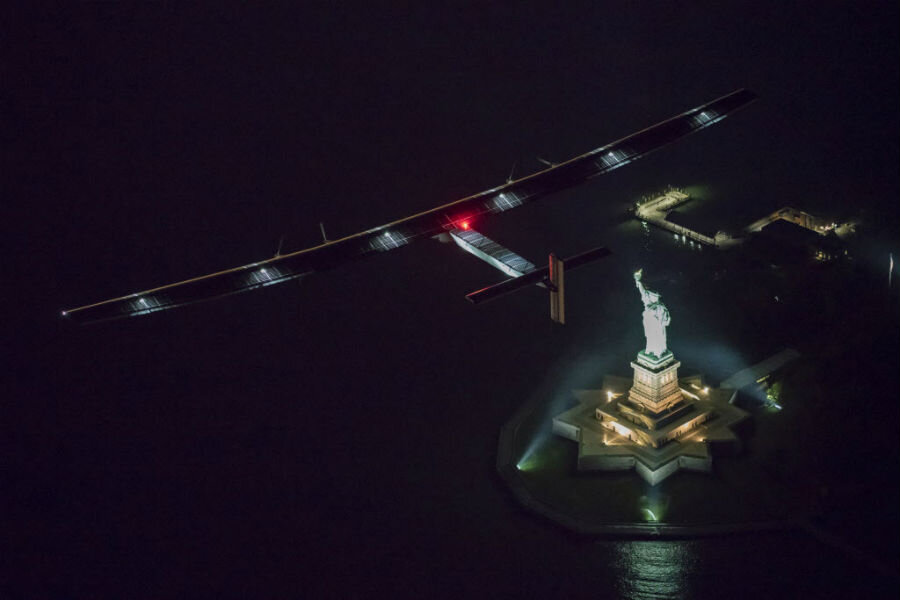Solar plane makes it across the US. Next stop: Europe
Loading...
In the early hours of Saturday morning, an aircraft with a suspiciously wide wingspan looped quietly around the Statue of Liberty before coming in for landing at John F. Kennedy airport.
The landing marked the completion of the US leg of what could be the world’s first circumnavigation by a solar-powered aircraft.
The plane, which uses no fuel, was manned by Swiss pilots Andre Borschberg and Bertrand Piccard, who began their journey eastward around the globe from Abu Dhabi in March 2015.
Their mission? To raise awareness about alternative sources of fuel.
As they approached Kennedy airport, Mr. Borschberg took a purposeful loop around New York Harbor.
"The US is a country where you meet a lot of entrepreneurs and pioneers,” he said to the BBC via satellite phone as he glided over the harbor, “and so to end our American crossing at the Statue of Liberty – which represents for me the freedom of enterprise and the freedom to innovate that is the spirit you can find in this country – is so symbolic."
Innovation has been a buzzword of the “Round-The-World Solar Flight,” which was first envisioned by Mr. Piccard, who has previously circumnavigated the world in a hot air balloon. The project is manned by over fifty technicians and engineers and funded by a range of corporate sponsors.
The Solar Impulse 2 is powered solely by its 17,000 solar cells, which cover the upper surface area of the wings and supply the plane’s four engines with renewable energy. While the entire plane weighs about as much as a car, its 72-meter wingspan stretches wider than a Boeing 747. Engineers needed that kind of surface area to ensure that the plane’s four engines were getting enough power.
The aircraft is able to fly at night due to large lithium batteries, which charge during the day and store energy.
The technology is far from jet-ready, reportedly reaching top speeds of 50 miles an hour, compared with a commercial jet’s 540 miles per hour. In addition, the plane was grounded in Hawaii for ten months for repairs after completing a nonstop five-day flight across the Pacific.
Their goal is to spark inspiration for green energy innovations, say the pilots.
“If governments had the courage to promote clean technologies on a massive scale, our society could simultaneously reduce its dependence on fossil fuels, create jobs, and stimulate sustainable growth,” said Piccard said in a statement.
Air traffic is a major culprit of ozone-deteriorating emissions and fossil fuel-guzzling. The Boeing 747 uses approximately one gallon of fuel per second. Due to their proximity to the ozone, scientists estimate that planes have about four times greater impact on global warming than cars releasing the same levels of pollutants.
Airplane emissions could more than triple by 2050, producing some 43 gigatons of carbon dioxide emissions between now and then, according to a study by the environmental advocacy group, Center for Biodiversity. The group has sued the Environmental Protection Agency for not taking enough action against emissions caused by transportation. Air travel and shipping will use up about 4 percent of the US carbon budget, the center reports.
The situation is not all bleak. Fuel efficiency has improved 45 percent from what it was in the late 1960s, and airlines are experimenting with fuel from farm waste or switching to more efficient jet engines.
And then there’s solar, a technology that the Solar Impulse 2 team hopes to keep in the public eye as they gear up for their trans-Atlantic flight and their ultimate return to Abu Dhabi.







